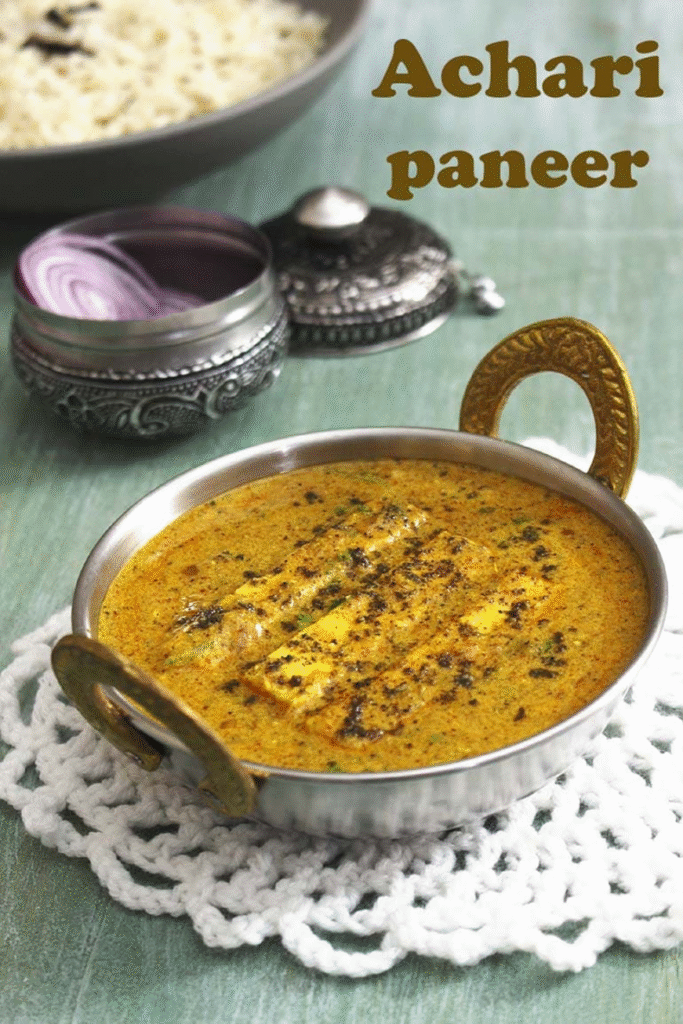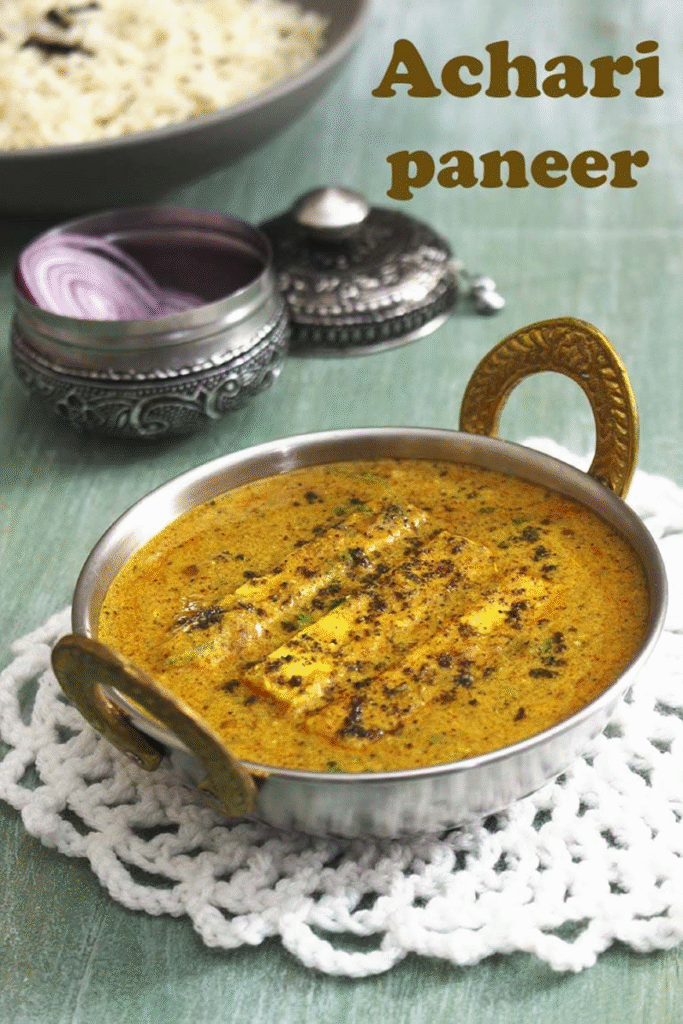Achari Paneer – Achari Paneer is a delicious and aromatic North Indian dish that brings together the rich, creamy texture of paneer (Indian cottage cheese) with the bold, tangy, and spicy flavors of traditional Indian pickles.
In this recipe, instead of using actual pickle, we replicate the signature taste of achar by blending a special mix of spices commonly used in Indian pickling—such as fennel seeds, mustard seeds, nigella seeds (kalonji), fenugreek, and asafoetida—into a robust, tangy sauce that coats the paneer beautifully.
What makes this dish stand out is its unique balance of spicy, sour, and aromatic notes. The achari Paneer (pickle spice mix) is typically dry-roasted and ground fresh to unlock its maximum flavor. This masala is then simmered with tomatoes, yogurt, and a hint of mustard oil to create a rich and tangy gravy that perfectly complements the soft chunks of paneer. It’s a dish that t
antalizes the palate and brings a punch of pickle-inspired zest to your meal, all without overpowering the main ingredient.
Achari Paneer is a perfect vegetarian delight that pairs wonderfully with naan, roti, or steamed basmati rice. Whether you’re looking to spice up a weeknight dinner or impress guests at a special gathering, this dish promises an unforgettable experience full of flavor, tradition, and creativity.

In this recipe, the distinct pickling flavors that define the character of Achari Paneer are carefully dry-roasted and then ground into a fine, aromatic spice blend. This process enhances the natural oils and fragrance of each spice, allowing them to release their full flavor potential. The spice mix typically includes a medley of traditional ingredients such as
fennel seeds, cumin, nigella seeds (kalonji), fenugreek seeds, and mustard seeds—each bringing its own contribution to the final taste profile. However, when preparing this achari masala, it is absolutely essential to pay close attention to the proportions, particularly when using fenugreek seeds (methi dana) and mustard seeds (sarson).
Both of these spices have intense, pungent flavors and can easily dominate the dish if not measured with care. Fenugreek seeds, in particular, have a naturally bitter undertone, which, while desirable in small quantities, can quickly become overwhelming if overused. Similarly, mustard seeds add a sharp, tangy heat, but an excess can make the gravy unpleasantly acrid. A slight error in their quantity can drastically alter the taste of the final dish, making it bitter and masking the delicate balance of the other spices. That’s why it’s crucial to use precise measurements and roast them gently, just until they begin to pop and release their aroma, without burning them.
The result of this carefully curated spice mix is a flavorful, well-balanced gravy that reflects the vibrant taste of Indian pickles, without the actual use of pickle oil or brine. This achari masala is the heart of the recipe, and its proper preparation is key to achieving that authentic, bold flavor that makes Achari Paneer so irresistibly delicious.
As you may mindful that Indian pickle (achaar) has an acrid taste. So to copy this taste, we are utilizing new yogurt (curd or dahi) here. This gives mellow, acrid taste to the gravy.
The addition of yogurt and heavy cream both makes the sauce creamy.
The by and large taste and flavor of this achari paneer masala sauce is exceptionally diverse and one of a kind compared to normal North Indian paneer flavors like paneer butter masala, kadai paneer, matar paneer, and paneer makhani, where onion and tomato are utilized for making gravy.
Step-by-Step Photo Instructions:
1) To begin the form, gather all the whole spices needed for the achari masala. These generally include fenugreek seeds( methi dana), mustard seeds( sarson), nigella seeds( kalonji), fennel seeds( saunf), and cumin seeds( jeera). Each of these spices contributes its own distinctive flavor to the masala — fennel adds a sweet and slightly licorice-like aroma, cumin brings earthiness, mustard seeds offer a sharp pungency, fenugreek lends a hint of bitterness, and kalonji imparts a subtle onion-garlic undertone. Place all these whole spices in a clean, dry skillet or vessel.
2) Set the visage over medium-low heat, allowing it to gradually warm up. Begin to dry repast the spices gently, stirring them continuously to insure they toast unevenly and don’t burn. This process should take about 3 to 5 twinkles, depending on the heat and the visage you’re using. As the spices repast, you’ll notice a pleasurable aroma begin to fill your kitchen, particularly the sweet notes of fennel and the earthy scent of cumin. Keep a close eye on the mustard seeds as they may start to expectorate slightly, signaling that they’ve released their essential canvases. This is your cue that the spices are duly heated.
Be careful not to over-roast or burn the spices, as this can lead to a bitter taste that will carry into the final dish. Once you notice the spices have slightly darkened in color and their scent is pronounced, incontinently remove the visage from the heat and allow the admixture to cool fully. Only when they’re completely cooled should you grind them into a coarse or fine greasepaint, depending on your preference. This lately roasted and ground achari masala will be the flavor backbone of your Achari Paneer, advancing it with a hand-made, such-like tang and aroma

3) Once the spices have been evenly roasted and the aroma is rich and toasty, carefully transfer them from the hot skillet into a clean, dry bowl. This is an important step, as leaving them in the hot pan may cause them to continue cooking from residual heat, which can lead to over-roasting or even slight burning, resulting in a bitter flavor. Spread the spices out gently in the bowl so they can cool more quickly and evenly. Let them sit undisturbed for a few minutes until they reach room temperature. This cooling period is essential before grinding, as it prevents moisture buildup and ensures a fine, smooth blend.
4) Once the spices have cooled completely, it’s time to grind them into a powder. You can use a spice grinder, a small dry jar of a mixer grinder (mixie), or even a mortar and pestle if you prefer a more traditional, coarse texture. Pulse the roasted spices until they form a fragrant, slightly coarse or fine powder, depending on your preference.
Some people enjoy a bit of texture in their achari masala, while others opt for a smoother blend. Either way, ensure that the spices are ground uniformly for a balanced flavor in every bite. Once ground, transfer the achari masala to a bowl or an airtight container and set it aside. This freshly prepared spice mix is now ready to be used in the recipe and will act as the soul of the dish, infusing the paneer with its signature achari (pickle-style) aroma and depth of flavor.

5) Next, it’s time to prepare the flavorful base for the Achari Paneer by tempering the mustard oil and sautéing the onions. Begin by pouring mustard oil into a heavy-bottomed pan or kadai and placing it over medium heat. Mustard oil is known for its sharp, pungent aroma and intense flavor, which is quite distinct from other cooking oils. To mellow its boldness and remove any raw aftertaste, it’s essential to heat the oil until it reaches its smoking point. You’ll know it’s ready when you see light smoke rising from the surface and the oil changes to a slightly golden hue.
At this stage, turn off the heat and allow the oil to cool for a minute or two. This step helps in reducing the harshness while retaining the characteristic flavor that makes mustard oil perfect for achari-style dishes. Once the oil has cooled slightly and the smoke has subsided, turn the heat back on to medium and allow the oil to reheat—this time, not to the smoking point, but just enough to continue cooking.
Now, add finely sliced or chopped onions to the warm oil. The onions should sizzle gently as they hit the pan. Stir them immediately to ensure even coating and prevent them from sticking. Sauté the onions patiently, stirring frequently, until they soften and begin to turn light golden brown. This process not only sweetens the onions but also forms the flavorful foundation of the dish, setting the stage for the achari masala and paneer to follow.
6) Continue cooking the onions over medium heat, stirring sometimes to insure they cook unevenly and don’t stick to the bottom of the pan. As the onions begin to soften, you’ll notice a change in both texture and color. The slices will gradationally turn from opaque white to a delicate, light pink or translucent tinge, signaling that they’re duly cooked. This metamorphosis is pivotal, as it indicates the onions have released their natural sugars and lost their raw bite, creating a mildly sweet and mellow base for the dish.
Avoid browning the onions too much at this stage, unlike some Indian dishes that bear deeply caramelized onions. Achari Paneer benefits from onions that are just gently softened and smoothly colored. This helps maintain the balance of pungent and racy flavors introduced later by the achari masala. The texture should be tender to the bite, and the aroma should be rich, slightly sweet, and inviting. Once the onions reach this point, you’re ready to move on to the next step and begin layering the spices and flavors that define this bold and vibrant paneer dish.

7) Now, include ginger paste and garlic paste.
8) Saute for 1 diminutive or till the crude scent of ginger garlic goes away.

9) Presently include salt, arranged pickle masala powder, red chili powder, turmeric powder, garam masala, and amchur powder.
10) Blend and saute for 30 seconds. This time lower the warm, so flavors do not get burnt.

11) Presently include besan.
12) Blend and saute for 1 minute with mixing constantly.

13) Presently include whisked, smooth yogurt and instantly blend with a spatula so it does not get curdled.
14) Include water and let it come to a boil, and at that point, turn the warm back to medium and proceed stewing for 4-5 minutes.

15) Include paneer.
16) Tenderly blend and stew for 1-2 minutes.

17) Include kasoori methi, mix.
18) Moreover, include overwhelming whipping cream.

19) Blend and cook for a minute.
20) In conclusion, include chopped coriander and serve.

the sauce will thicken more since we have included besan in the sauce. So if serving after a few time or after few hours, at that point keep the sauce marginally more slender by including small more water. So at the time of serving sauce has the right consistency.
Serving recommendation:
this achari paneer masala sauce goes well with tandoori roti, lachha paratha or plain paratha, naan or garlic naan. It can be served with straightforward basmati rice or jeera rice.

